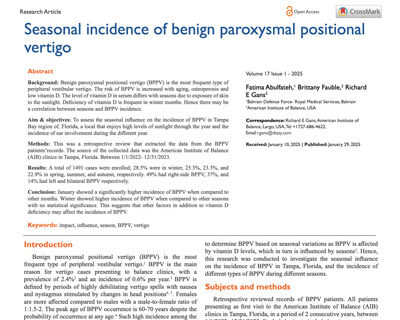
Seasonal incidence of benign paroxysmal positional vertigo
Published on: February 6, 2025
Journal of Otolaryngology – ENT Research | Volume 16 – Issue 1 – 2025
Benign paroxysmal positional vertigo (BPPV) is the most frequent type of peripheral vestibular vertigo.1 BPPV is the main reason for vertigo cases presenting to balance clinics, with a prevalence of 2.4%2 and an incidence of 0.6% per year.3 BPPV is defined by periods of highly debilitating vertigo spells with nausea and nystagmus stimulated by changes in head positions4, 5. Females are more affected compared to males with a male-to-female ratio of 1:1.5-2. The peak age of BPPV occurrence is 60-70 years despite the probability of occurrence at any age.4 Such high incidence among the elderly is related to the macula degeneration with the increased age.6 Additionally, individuals affected with BPPV are more predisposed to future dementia, strokes, fractures, and reduced quality of life, especially among elderly individuals.7,8 The majority of BPPV cases are idiopathic and only 5% experience manifestations with head trauma as the major cause.9 Despite the pathophysiology being poorly understood, the commonly acknowledged cause of BPPV is displaced otoconia that falls from the utricular macula into a semicircular canal. Head movements cause adherent deposits on the cupula (cupulolithiasis) or freely floating otoconia, which then react to head rotation or gravity to cause shearing forces on the cupula.10 BPPV risk is increased with aging, osteoporosis and osteopenia, low vitamin D, dehydration, and fluctuations in blood pressure and blood glucose.11,12 There is a possible association between vitamin D deficiency and BPPV; as vitamin D has a significant role in otoconial structure.13 It regulates the metabolism of calcium in the otoconia of the inner ear.14–17 The level of vitamin D in serum has been found to differ between seasons of the year due to the variation in seasonal insolation and exposure of skin to sunlight.18,19 Vitamin D deficiency is very common in the winter season and as a result, a relationship between seasons and BPPV incidence has been suggested.13 Therefore, it is necessary to determine BPPV based on seasonal variations as BPPV is affected by vitamin D levels, which in turn is influenced by seasons3. Hence, this research was conducted to investigate the seasonal influence on the incidence of BPPV in Tampa, Florida, and the incidence of different types of BPPV during different seasons.
Fatima Abulfateh, Brittany Fauble, Richard E Gans